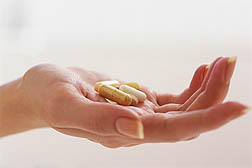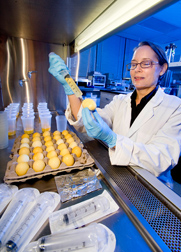| July 2009 |
Dietary Intervention Shows NeuroprotectionAdding a moderate, but not high, amount of walnuts to an otherwise healthy diet may help older individuals improve performance on tasks that require motor and behavioral skills, according to an animal model study by Agricultural Research Service (ARS)-funded scientists. Walnuts contain polyphenols and other antioxidants and essential fatty acids. The study found that in aged rats, diets containing 2 percent or 6 percent walnuts were able to improve age-related motor and cognitive shortfalls, while a diet containing 9 percent walnuts impaired reference memory. Scientific contact:James A. Joseph, (617) 556-3178, Jean Mayer USDA Human Nutrition Research Center on Aging, Boston, Mass. |
|
| Dietary Supplement Data Supports Nutrient Intake AssessmentsThe Dietary Supplement Ingredient Database (DSID), a newly launched resource from the Agricultural Research Service (ARS), has been developed to improve estimates of the U.S. population's nutrient intakes based not only on the beverages and foods people consume, but also on their dietary supplement intake. The database provides statistical estimates—based on chemical analysis—of the nutrient content of selected ingredients in dietary supplements, compared with label-reported ingredient levels. The first release of the DSID provides estimated levels of 18 vitamin and mineral ingredients derived from analytical data for 115 representative unspecified adult multivitamin/multimineral supplements. Scientific contact: Joanne M. Holden, (301) 504-0630, ARS Nutrient Data Laboratory, Beltsville, Agricultural Research Center, Beltsville, Md. |
New Food Safety Technology Developed for Liquid Egg ProductsAgricultural Research Service (ARS) scientists have filed a patent on technology that can protect pasteurized liquid eggs from food safety threats. The technology, called "crossflow microfiltration membrane separation" (CMF), is more effective than thermal pasteurization at removing pathogens from liquid egg products. And it does so without affecting the eggs' ability to foam, coagulate and emulsify, meaning that CMF-treated eggs could be safely substituted for pasteurized eggs in angel food cake and other products where those characteristics are desired. Although effective in its own right, CMF works best when used as an accompaniment to pasteurization, not a replacement for it. Combining the two processes significantly reduces the pathogen load. Scientific contact: Sudarsan Mukhopadhyay, (215) 233-6600, ARS Eastern Regional Research Center, Wyndmoor, Pa. |
|
| Benefits of Compound in Turmeric Spice StudiedDietary curcumin could stall the spread of fat tissue by inhibiting new blood vessel growth, called angiogenesis, which is necessary to build the new tissue, according to a new Agricultural Research Service (ARS) study. Curcumin is a bioactive component in curry and turmeric that has been consumed daily in Asian countries for centuries without reported toxic effects. The ARS study found that supplementing animals’ high-fat diet with curcumin reduced body weight gain and total body fat, even though food intake was not affected, when compared to the non-supplemented high-fat-diet group. The curcumin-treated group also had less blood vessel growth in fat tissue. Blood glucose, triglyceride, fatty acid, cholesterol and liver fat levels also were lower in the group that received the curcumin. Scientific contact: Mohsen Meydani, (617) 556-3126, Jean Mayer USDA Human Nutrition Research Center on Aging, Boston, Mass. |
Botulism Assay Quickly Detects Potent Foodborne ToxinAgricultural Research Service (ARS) scientists at the agency’s Western Regional Research Center in Albany, Calif., have developed a new, improved test for detecting what's known as serotype A of the botulinum toxin. This toxin, which causes botulism, exists in seven different serotypes, labeled A through G. Serotypes A and B are the culprits in most of the foodborne botulism cases in this country. For decades, the "gold standard" of tests for detecting botulinum toxin has been an assay that requires laboratory mice. That assay takes at least four days to perform correctly, and is neither portable nor economical. In contrast, the assay developed by the ARS scientists relies on laboratory-built molecules known as monoclonal antibodies. The ARS-developed assay is 10 times more sensitive than the mouse assay, yet is easier to use and less expensive. Scientific contact: Larry H. Stanker, (510) 559-5984, Foodborne Contaminants Research Unit, ARS Western Regional Research Center, Albany, Calif. |
|
| "Alkali Load" May Help Conserve Bone and MuscleA new study funded by the Agricultural Research Service (ARS) suggests that reducing the acid load that accompanies the typical high protein diet may be important in helping to preserve bone and muscle mass. In the study with 19 healthy volunteers on a controlled diet, participants taking 3,510 milligrams daily of potassium bicarbonate in capsules had reduced urinary nitrogen excretion, an indicator of reduced muscle wasting, compared to another group of participants who took a placebo. The “alkalinized” group also had higher levels of IGF-1, a marker of both muscle and bone conservation, and of calcium absorption, a marker of bone conservation, compared to the placebo group. Scientific contact: Bess Dawson-Hughes, (617) 556-3064, Jean Mayer USDA Human Nutrition Research Center on Aging, Boston, Mass. |
Analyzing Caffeine in Selected Dietary SupplementsAgricultural Research Service (ARS) scientists in Beltsville, Md., have analyzed a number of caffeine-containing products to explore caffeine levels in segments of the U.S. dietary supplement market. Approximately half of the tested products contained the caffeine equivalent of up to two cups of coffee per day. Of the 28 analyzed products that voluntarily listed a caffeine amount on the label, 25 were found to contain caffeine levels within 20 percent of the label amount. Scientific contact: Janet Roseland, (301) 504-0715, Beltsville Human Nutrition Research Center, ARS Henry A. Wallace Beltsville Agricultural Research Center, Beltsville, Md. |
|
| Salmonella Strain's Path to Virulence UncoveredAgricultural Research Service (ARS) scientists have uncovered genetic evidence about the evolutionary path that transformed Salmonella enteritidis from an innocuous bacterium into a virulent pathogen. The ARS scientists found S. enteritidis strains to be so similar genetically that they appear identical, yet they may behave differently inside the hen. Through these analyses, the researchers developed a timeline of when S. enteritidis first became capable of getting inside the egg from hen reproductive organs—approximately 36 years ago. It appears that a large-scale swap of DNA between strains, in association with the emergence of egg contamination, created a hybrid strain of S. enteritidis. This hybrid strain had the ability to contaminate the internal contents of eggs. Later, the hybrid strain split into two lineages, each carrying one virus. Scientific contact: Jean Guard-Bouldin, (706) 546-3446, ARS Egg Safety and Quality Research Unit, Athens, Ga. |
Red Fungus Turned Orange May Help Tackle Vitamin DeficiencyThe edible fungus Monascus purpureus imparts a distinct flavor and red color when added to fermented rice dishes such as those served in Asia. Now, the fungus could offer a way to address a major public health concern: vitamin A deficiency. In studies at the Agricultural Research Service (ARS) Wheat Genetics, Quality, Physiology and Disease Research Unit in Pullman, Wash., researchers replaced the fungus' pigment-producing genes with two from another species that makes beta-carotene, which the human body readily converts to vitamin A. The scientists used equipment popularly called a “gene gun” to fire two copies of beta-carotene genes from the fungus Blakeslea trispora into the DNA of Monascus, enabling it to make the orange-colored pigment. They believe the modified Monascus can produce about as much beta-carotene as a carrot, under the right growth conditions. Scientific contact: Daniel Z. Skinner, (509) 335-8696, ARS Wheat Genetics, Quality, Physiology and Disease Research Unit, Pullman, Wash. |
|
| New Techniques Developed for TSE TestingAgricultural Research Service (ARS) researchers have found a way to facilitate the diagnosis of transmissible spongiform encephalopathies (TSEs), a deadly group of diseases that can develop in a range of mammals, including humans. A TSE can only be definitely diagnosed after an animal has died. During the diagnosis, researchers typically check tissues for abnormal proteins called prions using a technique called Western blotting, in the case of fresh or frozen tissue, or with immunohistochemistry if the tissue that has never been frozen and is fixed in formalin, a solution used to preserve biological specimens. Sometimes only formalin-fixed tissues are available for testing. The ARS scientists found a way to extract and identify abnormal prions in formalin-fixed tissue using a combination of mild detergent, a series of freeze-boil cycles, and enzyme digestion. Initial results indicate that the accuracy of this method begins to decline two years after the tissue is first preserved, and is completely lost at the end of six years. Scientific contact: Eric M. Nicholson, (515) 663-7443, Virus and Prion Diseases of Livestock Unit, ARS National Animal Disease Center, Ames, Iowa. |











